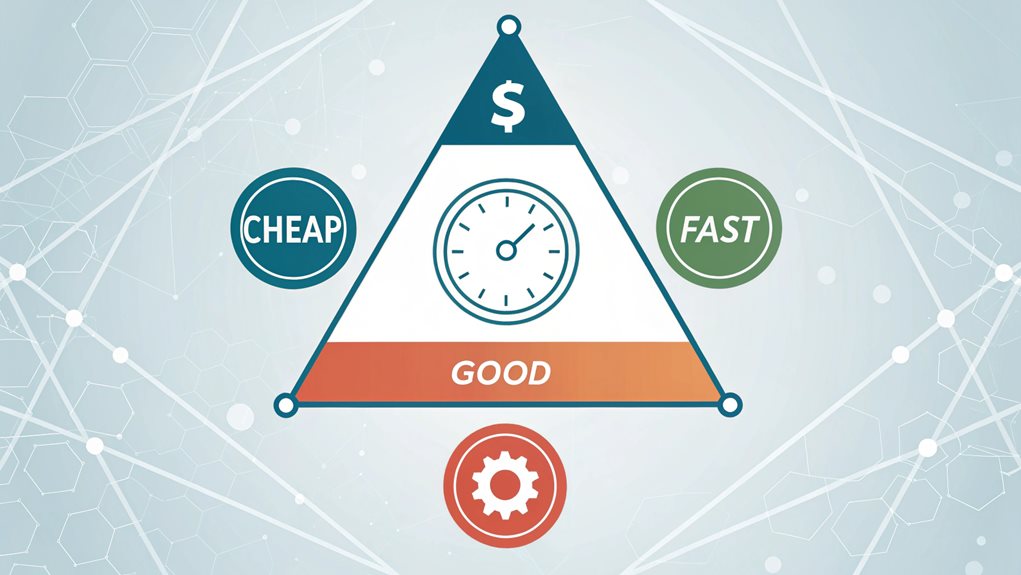
Cheap, Fast, or Good: The Truth About Web Design Trade-offs for Small Businesses
Small business websites face an unavoidable triangle of constraints: affordable, fast, or good—pick only two. Choosing speed and affordability sacrifices quality, potentially driving customers away and requiring costly redesigns later. Opting for quality and speed increases costs considerably, while prioritizing affordability and quality extends timelines. Strategic prioritization based on specific business needs allows for informed compromises, whether through phased implementation, template solutions, or professional development. Understanding these trade-offs helps businesses maximize their investment while avoiding expensive mistakes.
Expert Highlights
- Web design projects can only achieve two of three qualities: affordability, speed, and quality – requiring strategic prioritization.
- Poor website design leads to hidden costs like lost revenue, reputation damage, and eventual redesign expenses.
- Successful website projects typically require 6-12 weeks, and underestimating complexity leads to unrealistic timelines.
- Professional design enhances trustworthiness, improves conversion rates, and reduces bounce rates compared to cheaper alternatives.
- Phased implementation allows small businesses to prioritize core functionality initially while maintaining quality standards.
Understanding the Web Design Triangle: Cheap, Fast, and Good

When small business owners commence on web design projects, they inevitably encounter the classic “Web Design Triangle,” a fundamental concept that shapes every decision in the process. This principle states that projects can only effectively achieve two of three qualities: affordability, speed, and quality—never all three simultaneously.
Selecting cost-effectiveness and rapid delivery typically sacrifices quality, resulting in websites that may underperform in conversion rates or user experience. Choosing quality and speed increases costs substantially as resources must be concentrated intensively. Meanwhile, prioritizing affordability and quality requires extended timelines, which may delay market entry or campaign launches.
The solution lies in strategic prioritization based on business needs. Identifying which two factors align with current goals enables owners to make informed compromises rather than pursuing unrealistic expectations that lead to disappointment. Our team emphasizes rigorous testing procedures throughout all development phases to ensure even budget-conscious projects maintain essential quality standards.
When Budget Matters Most: Navigating Low-Cost Web Solutions

For many small business owners, budget constraints represent the primary consideration when approaching web design projects. Limited funds create significant challenges, often forcing tough decisions between essential features and desirable aesthetics.
Fortunately, several viable options exist for cost-conscious entrepreneurs. Template-based platforms like Wix, Squarespace, and WordPress offer professionally designed frameworks at a fraction of custom development costs. These solutions provide responsive designs that work across devices while requiring minimal technical knowledge. Additionally, phased implementation approaches allow businesses to start with core functionality—contact forms, basic product listings, and essential information pages—then expand as resources become available. Some owners find success by trading services with web designers or hiring talented students seeking portfolio projects, creating mutually beneficial arrangements that deliver quality results without depleting limited capital. Implementing proper CMS integration can significantly reduce long-term costs by allowing business owners to manage their content without requiring developer assistance for every update.
The Need for Speed: Accelerating Your Website Launch

When launching a small business website quickly, owners must establish realistic timelines that account for essential development phases while preventing rushed, error-filled implementations. Prioritizing critical page elements—such as contact information, core product details, and compelling calls-to-action—allows businesses to launch with a functional minimum viable product rather than waiting for perfection. Streamlining site structure through simplified navigation and focused content not only accelerates development but also creates a more intuitive user experience that converts visitors into customers more effectively. Implementing custom UI/UX design tailored specifically to user needs can significantly enhance both functionality and aesthetics without extending development timelines.
Setting Realistic Timelines
Because many small business owners underestimate the complexity involved in website development, they often set unrealistic launch deadlines that lead to frustration and compromised quality. They fail to account for inevitable revisions, content creation delays, and technical challenges that emerge during the process, resulting in rushed implementations that undermine business goals.
Successful website projects require thorough timeline planning that includes buffer periods. Small business owners should work with their developers to create detailed project schedules with clearly defined milestones for design approval, content submission, development phases, testing, and revisions. These realistic timelines should allocate extra days for unexpected issues and client feedback integration. When businesses understand that quality websites typically require 6-12 weeks rather than days, they can properly plan marketing activities around launch dates, reducing stress while ensuring the final product effectively represents their brand.
Prioritizing Page Elements
The strategic selection of page elements represents a critical decision point for small businesses with limited time and resources. When every pixel matters, businesses must distinguish between essential components that drive conversions and decorative elements that might slow loading times or distract visitors.
Many small business sites falter when attempting to include everything at once—multiple contact forms, animation galleries, and third-party widgets that compete for attention. Instead, successful launches prioritize a clean navigation structure, compelling value propositions, and clear calls-to-action. For example, rather than implementing a resource-intensive video background, businesses might opt for a high-quality static image with targeted messaging that loads instantly. This approach guarantees visitors immediately understand what the business offers without waiting through lengthy loading sequences that increase bounce rates and frustrate potential customers.
Streamlining Site Structure
Beyond prioritizing individual page elements, a streamlined site structure forms the backbone of any high-performing small business website. When visitors can easily navigate and find information, they’re more likely to convert into customers. Simplifying your site architecture accelerates both development time and page load speeds.
A well-organized site structure includes:
- A clear hierarchy with no more than 3-4 navigation levels
- Intuitive menu categories that match how customers search for information
- Consistent URL structures that follow logical patterns (domain.com/category/subcategory)
- Strategic internal linking that guides visitors toward conversion points
Many small businesses struggle with overly complex navigation systems that confuse visitors and slow development. By mapping your site structure before building, you’ll create a more cohesive user experience while reducing development costs and timeline.
Quality Craftsmanship: Why Good Design Pays Dividends
Investing in quality design represents one of the most significant decisions a small business owner can make when establishing an online presence. Professional design communicates trustworthiness and credibility, ultimately determining whether visitors convert to customers or bounce to competitors. Research shows that users form opinions about websites within milliseconds, making quality non-negotiable for businesses serious about growth. As demonstrated by WebLeadsNow’s approach, user-centered design creates intuitive experiences that dramatically improve customer engagement and conversion rates.
| Quality Design Element | Return on Investment |
|---|---|
| Responsive layouts | 67% higher conversion rates |
| Professional imagery | 38% increased trust signals |
| Intuitive navigation | 61% reduced bounce rates |
| Strategic CTAs | 90% improved lead generation |
| Consistent branding | 23% better brand recognition |
While quality design requires greater initial investment, its benefits far outweigh the costs. Companies that prioritize craftsmanship experience enhanced customer perception, increased engagement, and ultimately, stronger revenue performance—transforming good design from an expense into a powerful business asset.
The Hidden Costs of Cheap Web Design
Why do many small business owners gravitate toward bargain-basement web design solutions when they inevitably lead to greater expenses down the road? The initial appeal of saving money often blinds entrepreneurs to the long-term consequences that accompany cut-rate websites. While upfront costs may seem attractive, these apparent savings quickly evaporate when reality sets in.
The pursuit of cheap web design is a costly illusion that trades immediate savings for long-term business consequences.
The true costs of cheap web design include:
- Lost revenue from poor user experience driving potential customers away
- Ongoing maintenance expenses for fixing frequent technical issues
- Reputation damage when professional clients judge your business by its subpar digital presence
- Eventual redesign costs when the inadequate site fails to perform essential business functions
Professional web designers understand that effective websites require thoughtful investment. Companies that prioritize quality design ultimately spend less while gaining more substantial returns through increased conversions, stronger customer trust, and seamless functionality. Investing in custom, responsive websites developed by experienced professionals ensures optimal user experience and better business outcomes, as demonstrated by WebLeadsNow’s 15+ years of expertise in this field.
Timelines vs. Thoroughness: Finding Your Balance
Urgency often drives small business owners to push for rapid website completion, creating tension between speed and quality in the development process. When facing tight deadlines, vital elements like user testing, content refinement, and cross-browser compatibility checks may be sacrificed, resulting in a website that looks finished but performs poorly.
The solution lies in strategic prioritization. Business owners should collaborate with developers to identify essential features for the initial launch while planning for phased improvements. This balanced approach guarantees the most critical business needs are met promptly while allowing time for thorough execution. For example, launching with a polished homepage and contact functionality first, then adding e-commerce capabilities in phase two, creates a more sustainable development rhythm. This methodology delivers a professional online presence quickly without compromising the thoroughness that builds customer trust. Implementing a microservices architecture can further enhance this phased approach by allowing individual components to be developed, tested and scaled independently.
Case Studies: Real-World Trade-offs and Outcomes
While examining theoretical web design principles provides valuable guidance, analyzing actual small business website projects reveals the tangible consequences of different decision-making approaches. These real-world examples demonstrate how various trade-offs impact business outcomes, customer satisfaction, and long-term digital success.
- A local bakery prioritized speed over quality, launching quickly with template designs that required complete rebuilding six months later when customer confusion resulted in declining orders.
- An accounting firm invested in thorough planning and quality development, accepting a longer timeline that ultimately delivered 40% higher conversion rates than industry averages.
- A fitness studio balanced speed and quality through phased implementation, launching core features quickly while adding functionality strategically over time.
- A boutique retailer’s budget constraints led to DIY development that cost more through lost sales than professional services would have required.
Decision Framework: Prioritizing Your Business Needs
These case studies reveal a common thread: successful small business websites stem from intentional decision-making aligned with specific business objectives. Small business owners must evaluate their specific needs through a structured framework that balances resources against priorities.
Begin by identifying your non-negotiable requirements—whether it’s lead generation, brand visibility, or e-commerce functionality. Then assess your constraints: budget limitations, time pressure, and quality standards. This evaluation creates a decision matrix where trade-offs become clearer.
For example, a service-based business might prioritize lead capture forms and testimonials over elaborate design elements, while a boutique retailer needs high-quality product imagery and secure checkout functionality. By ranking priorities against resources, owners can make informed decisions about where to invest and where to compromise, ensuring the final website delivers maximum value for their specific business model.
Strategic Compromises: Making the Most of Limited Resources
When small businesses face resource constraints, strategic compromises become essential for creating effective websites without breaking the bank. Successful entrepreneurs understand that intelligent trade-offs, rather than cutting corners haphazardly, lead to sustainable digital solutions that meet core business objectives while respecting budgetary limitations.
- Phased development – Implement critical features first, then add secondary elements as resources become available
- Template customization – Select premium templates that can be personalized rather than building completely custom designs
- Content prioritization – Focus resources on high-conversion pages while using simpler designs for secondary information
- Selective outsourcing – Retain professional help for technically complex components while handling routine updates in-house
These approaches enable small businesses to allocate limited resources strategically, resulting in professional websites that effectively support business goals without requiring excessive investment.
Frequently Asked Questions
How Often Should I Redesign My Small Business Website?
Small businesses should redesign their websites every 2-3 years. However, ongoing updates to content, functionality, and security should happen regularly between major redesigns to maintain relevance.
Do I Need Ongoing Maintenance After My Website Launches?
Yes, ongoing maintenance is essential. Websites require regular updates, security patches, content refreshes, and technical monitoring to guarantee peak performance, security, and relevance in today’s digital community.
Can I Update My Website Myself Without Technical Skills?
Yes, most modern websites include user-friendly content management systems that allow non-technical owners to update text, images, and basic content without coding knowledge or professional assistance.
What Metrics Determine if My Website Design Is Successful?
Success metrics include conversion rates, bounce rates, user engagement time, mobile responsiveness, and search engine rankings. Businesses should analyze these alongside customer feedback to determine if their website meets community expectations.
How Do Hosting Choices Affect My Website’s Performance and Budget?
Hosting choices directly impact website speed, uptime, and security. Premium hosts offer better performance and support but cost more, while budget options may compromise reliability for savings.
Expert Final Thoughts
Small business owners cannot escape the web design triangle‘s reality: cheap, fast, or good—pick two. By understanding their true priorities and accepting strategic compromises, businesses can make informed decisions that align with their goals. Whether choosing template solutions, extending timelines for quality, or investing more for premium results, success comes from recognizing limitations and maximizing the resources available rather than pursuing perfection in all three dimensions.